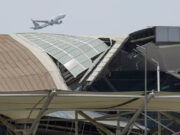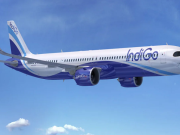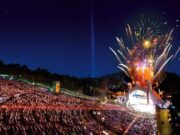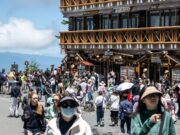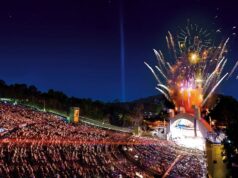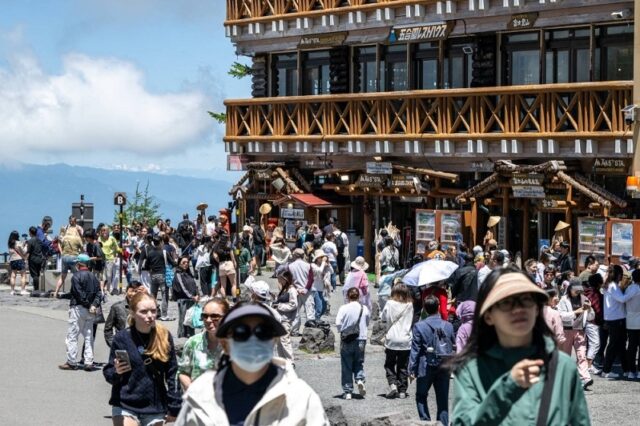
Yamanashi Prefecture will begin charging an entrance fee of ¥2,000 to all climbers looking to ascend the most popular route up Mount Fuji as the climbing season starts Monday. The new fee is part of an effort to ease congestion and prevent unsafe climbing.
The overtourism countermeasure, which also includes capping the number of daily climbers at 4,000, marks the first time that climbing one of Japan’s most enduring symbols will cost money.
“As more and more climbers visit Mount Fuji, it has long been plagued by the danger of accidents caused by overcrowding near the summit, increased environmental impact due to illegal dumping of trash and poor manners by spontaneous climbers,” Yamanashi Gov. Kotaro Nagasaki told reporters in June during a test run of the new system.
“Overtourism on Mount Fuji is an urgent issue that cannot wait to be addressed and has been a challenge for us since it was registered as a World Heritage Site (in 2013). We are therefore launching a new initiative that will push our country’s overtourism prevention measures forward.”
The entrance fee will apply to the mountain’s most popular and commonly used route, the Yoshida trail, and those who are planning to climb beyond the 5th Station will now be required to pay a fee of ¥2,000 at the booth near its entrance. Both cash and credit cards will be accepted.
Visitors who pay for admission will receive a wristband that must be worn in order to be admitted through a temporary gate set up for this year’s climbing season, with a guard stationed nearby at all times. Nagasaki says that a permanent gate will be constructed for the 2025 season after the current season ends in September.
The gate will only be open between 3 a.m. to 4 p.m., restricting entry to between those times.
In order to prevent overcrowding on the trail — an issue that the mountain has faced in recent years as tourism in the country has spiked — the prefecture will now limit the number of visitors admitted through the gate at 4,000 per day and will refuse entry to those who come after.
Updates on how many people have started on the trail each day will be made through the mountain’s official X account and staff will keep visitors at the foot of the mountain updated in order to prevent situations where climbers are turned around at the 5th Station.
To secure a spot, the prefectural government encourages visitors to utilise the reservation portal on the mountain’s official website to book and pay entrance fees in advance for a set day during the climbing season, which lasts from July 1 to Sept. 10.
It has been rare for the number of climbers to exceed 4,000 — it only happened on five days in 2023, and between 10 to 20 days a year prior to the pandemic.
With the new regulatory measures, Nagasaki says he hopes that Mount Fuji’s World Heritage legacy can be conserved by reducing environmental damage and using the money earned from entrance fees to fortify the system and related facilities.
Efforts are also being made to prevent unsafe climbing by “bullet climbers” — visitors who choose to scale Mount Fuji on a whim, arriving unprepared and then experiencing things like altitude sickness and hypothermia on the trail.
That said, for the many foreign tourists who visit the mountain, the additional fee seems to be of little concern.
“Considering (the money) will go into the upkeep of the trail and everything, I think it’s worth it,” said Bryce Gaul, a traveller from Australia in his 20s who was visiting Mount Fuji for the first time. “I know that tourism brings a lot of money to the economy, so why not?”
“It would not stop my choice (to climb Mount Fuji),” added Kimberly who was visiting from Minnesota with her family. She requested that her surname not be published. “In the United States you pay a fee anyways of similar amounts to go to the national parks — it’s probably inevitable.”
However, to workers doing business in the area, the measure could hit their bottom line.
“It’s the first-ever case of its kind so I don’t know (the effects of it) until it starts,” said an employee working the horse-riding booth at the 5th Station who requested to remain anonymous for privacy reasons. “But I do think it’s unfair that they are only doing it here (at the 5th Station) when there are many entrances.”
Indeed, the fact that the regulations will be put in place for only one route in Yamanashi Prefecture has raised concerns that it may just push the climbers to the Shizuoka Prefecture side of the mountain and overcrowd other trails, a scenario that Nagasaki admits may happen.
“Shizuoka Prefecture is also taking action and so each prefecture is implementing measures independently and concurrently,” he noted at a news conference in June. “But after the climbing season is finished there will be a pooling of knowledge and information, including a sharing of ideas of how we can improve existing measures and how the two prefectures can best work together in the long term.”
The gate at the Yoshida trail will be a test run for this climbing season, Nagasaki said. Depending on its effectiveness, other measures may be implemented along other routes in following years.




